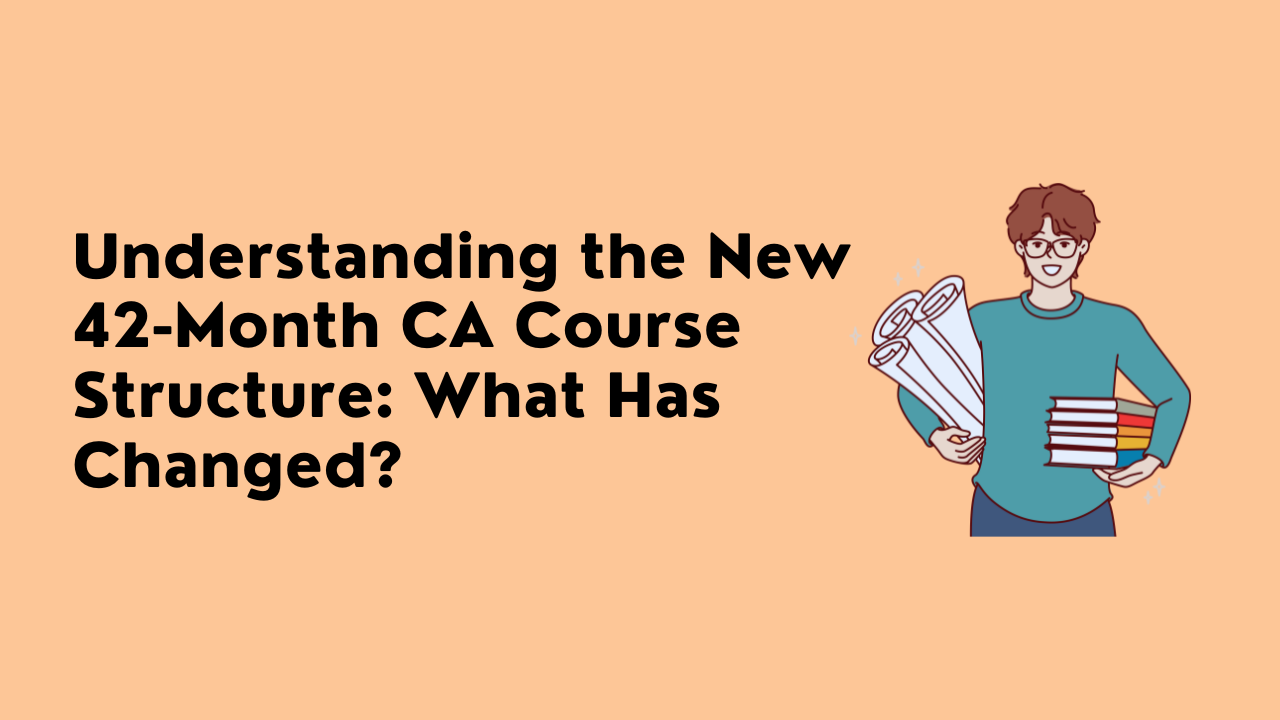
It is well acknowledged that the Chartered Accountancy (CA) programme is among the most difficult professional programmes offered in India. The most recent change to the course's 42-month duration signifies a substantial change in the way prospective CAs will approach their studies because the Institute of Chartered Accountants of India (ICAI) updates it on a regular basis to meet the changing needs of the industry. This new structure affects not only the length but also the curriculum, training, and methods of assessment. Let's examine the changes and what they signify for those aspiring to become CAs.
The move to a 42-months timetable is the most noticeable modification to the new CA course structure. The CA program used to take at least 48 months to complete, including a three-year articleship (practical training). Many students are happy about the shorter duration because it will enable them to finish the course more quickly and start working in the workforce sooner.
However, the shortened time frame also means that students must study with greater efficiency and intensity. The course's rigor and content will not be diminished by the shorter duration. Instead, it calls for a more efficient and cohesive method of instruction, where theoretical understanding is more closely matched with hands-on training. To navigate this demanding schedule successfully, students must also focus on the right study materials, particularly CA Entrance Exam Books, which play a crucial role in building a strong foundation early in the course.
Revisions to the curriculum are among the major adjustments that come with the new structure. In order to keep the syllabus contemporary and applicable to the current business and economic climate, the ICAI has taken action to modernize it. This covers the addition of fresh topics as well as the update of current ones to match modern methods.
As an example, the curriculum now gives more weight to data analytics, sustainability reporting, and digital finance—areas that are becoming more and more important in today's business environment. Furthermore, there is an increased emphasis on honing analytical and problem-solving abilities, which are critical for success in the accounting and financial industries. To assist students in navigating these changes, Scanner CA Intermediate Books have become a valuable resource, offering an organized approach to covering both new and updated topics efficiently.
There is also a more integrated approach to training and education with the new 42-month structure. The updated framework more successfully integrates theoretical knowledge and practical experience, reflecting the ICAI's recognition of the value of doing so.
During their articleship, students will have more chances under the new approach to apply what they have learned in the classroom to actual situations. Utilizing resources like the CA Intermediate Scanner can further enhance this learning by providing a focused review of important topics and questions. By bridging the gap between theory and practice, this integration helps students graduate from the course more industry-ready.
The assessment procedure has been modified, which is another noteworthy alteration. Exams for the CA degree are famously challenging and demanding, and this has historically been a big obstacle for students. The ICAI made modifications to the new structure that should make the assessment process less stressful and more ongoing.
During the articleship, this includes introducing more frequent internal assessments and project-based evaluations. These adjustments are meant to ease the stress associated with final exams and promote a more regular and stable study schedule. The goal of the ICAI's ongoing assessment program is to make sure that students are learning and implementing their material during the course, as opposed to only studying for tests.
The new CA course structure offers students more flexibility, allowing them to tailor their learning routes to align with their career goals. The Institute of Chartered Accountants of India (ICAI) has introduced a broader selection of elective courses, enabling students to focus on areas of interest such as forensic accounting, international taxes, and financial services. This expanded choice in Study Material For CA allows students to specialize in their preferred fields, making the course more appealing to a wider range of students. Moreover, this flexibility ensures that students are better prepared to tackle the unique challenges they will encounter in their chosen career pathways.
The way chartered accountancy is taught and acquired in India has undergone a substantial change with the introduction of the 42-month CA course framework. The ICAI has streamlined examinations, shortened the time, updated the curriculum, integrated training and education, provided greater flexibility, and improved the course's alignment with industry and student needs. Alongside these changes, the importance of selecting the right books for the CA Exam has become even more critical for students aiming to excel in their studies.
Although the changes present new challenges, they also offer students exciting chances to acquire the information and skills needed to succeed in the rapidly changing finance and accounting industries. The new framework provides prospective CAs with a more effective, pertinent, and adaptable route to reaching their career objectives.
© 2024 Scanner Adda All rights reserved | Design by Shuchita Technologies